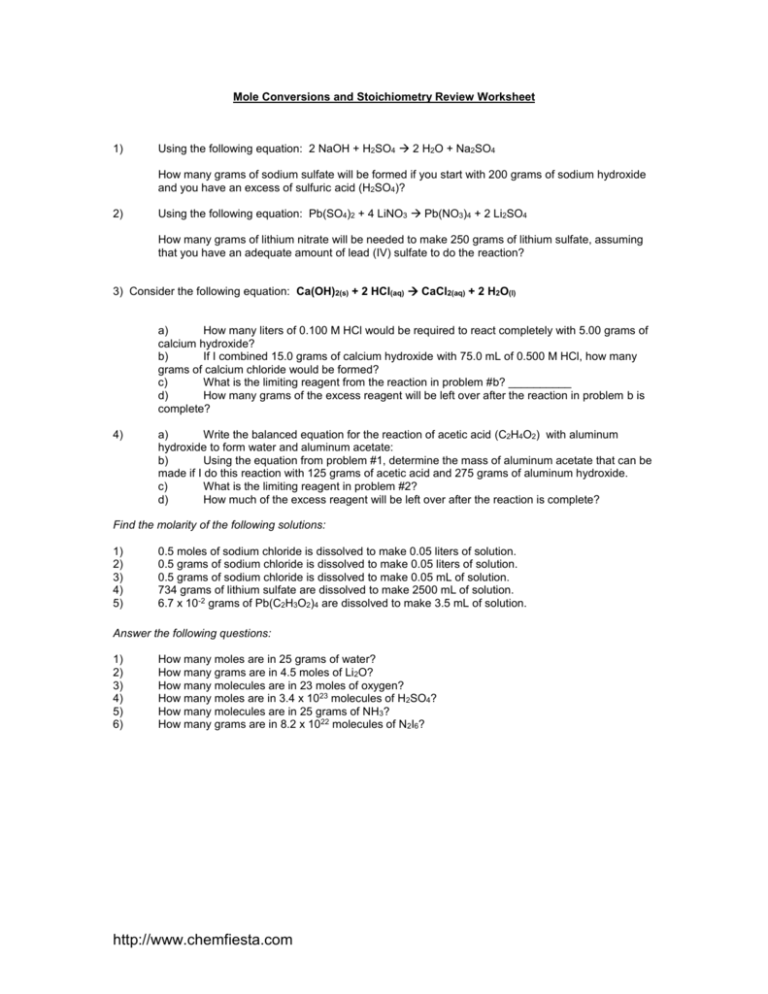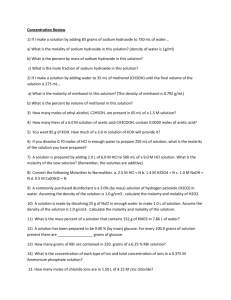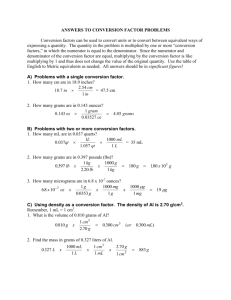Stoichiometry Practice Worksheet
advertisement

Mole Conversions and Stoichiometry Review Worksheet 1) Using the following equation: 2 NaOH + H2SO4 2 H2O + Na2SO4 How many grams of sodium sulfate will be formed if you start with 200 grams of sodium hydroxide and you have an excess of sulfuric acid (H2SO4)? 2) Using the following equation: Pb(SO4)2 + 4 LiNO3 Pb(NO3)4 + 2 Li2SO4 How many grams of lithium nitrate will be needed to make 250 grams of lithium sulfate, assuming that you have an adequate amount of lead (IV) sulfate to do the reaction? 3) Consider the following equation: Ca(OH)2(s) + 2 HCl(aq) CaCl2(aq) + 2 H2O(l) a) How many liters of 0.100 M HCl would be required to react completely with 5.00 grams of calcium hydroxide? b) If I combined 15.0 grams of calcium hydroxide with 75.0 mL of 0.500 M HCl, how many grams of calcium chloride would be formed? c) What is the limiting reagent from the reaction in problem #b? __________ d) How many grams of the excess reagent will be left over after the reaction in problem b is complete? 4) a) Write the balanced equation for the reaction of acetic acid (C2H4O2) with aluminum hydroxide to form water and aluminum acetate: b) Using the equation from problem #1, determine the mass of aluminum acetate that can be made if I do this reaction with 125 grams of acetic acid and 275 grams of aluminum hydroxide. c) What is the limiting reagent in problem #2? d) How much of the excess reagent will be left over after the reaction is complete? Find the molarity of the following solutions: 1) 2) 3) 4) 5) 0.5 moles of sodium chloride is dissolved to make 0.05 liters of solution. 0.5 grams of sodium chloride is dissolved to make 0.05 liters of solution. 0.5 grams of sodium chloride is dissolved to make 0.05 mL of solution. 734 grams of lithium sulfate are dissolved to make 2500 mL of solution. 6.7 x 10-2 grams of Pb(C2H3O2)4 are dissolved to make 3.5 mL of solution. Answer the following questions: 1) 2) 3) 4) 5) 6) How many moles are in 25 grams of water? How many grams are in 4.5 moles of Li2O? How many molecules are in 23 moles of oxygen? How many moles are in 3.4 x 1023 molecules of H2SO4? How many molecules are in 25 grams of NH3? How many grams are in 8.2 x 1022 molecules of N2I6? http://www.chemfiesta.com Solutions for the Stoichiometry Practice Worksheet: 1) 355.3 grams of Na2SO4 2) 313.6 grams of LiNO3 3) a)How many liters of 0.100 M HCl would be required to react completely with 5.00 grams of calcium hydroxide? Using plain ol’ stoichiometry, you should find that it will require 0.0135 moles of HCl to react with 5.00 g Ca(OH)2. Using the equation M = mol/L, this translates to 0.135 L of 0.100 M HCl. b) If I combined 15.0 grams of calcium hydroxide with 75.0 mL of 0.500 M HCl, how many grams of calcium chloride would be formed? 2.08 grams c) What is the limiting reagent from the reaction in problem #3? HCl d) How many grams of the excess reagent will be left over after the reaction in problem 3 is complete? 13.6 grams of Ca(OH)2 4) a) Write the balanced equation for the reaction of acetic acid with aluminum hydroxide to form water and aluminum acetate: 3 C2H3O2H + Al(OH)3 Al(C2H3O2)3 + 3 H2O b) Using the equation from problem #1, determine the mass of aluminum acetate that can be made if I do this reaction with 125 grams of acetic acid and 275 grams of aluminum hydroxide. Two calculations are required. One determines the quantity of aluminum acetate that can be made with 125 grams of acetic acid and the other determines the quantity of aluminum acetate that can be made using 275 grams of aluminum hydroxide. The smaller of these two answers is correct, and the reagent that leads to this answer is the limiting reagent. Both calculations are shown below – the correct answer is circled. c) What is the limiting reagent in problem #2? Acetic acid. d) How much of the excess reagent will be left over after the reaction is complete? http://www.chemfiesta.com Solutions to the Molarity Practice Worksheet For the first five problems, you need to use the equation that says that the molarity of a solution is equal to the number of moles of solute divided by the number of liters of solution. 1) In this problem, simply solve using the molarity equation to find that the concentration of the solution is 10 M. 2) To use the molarity equation, you need to convert grams of sodium chloride to moles of sodium chloride before you can use the molarity equation. Because you have 0.0085 moles of NaCl in this solution, the total concentration is 0.17 M. 3) To use the molarity equation, you need to convert grams of NaCl to moles and mL of solution to liters. When you do this, the total concentration of the solution is 170.9 M. As it turns out, this isn’t a realistic value for molarity, so you’d never see a solution with this concentration out in the real world. Why did I give it to you then? I did it because I wanted you to see that just by changing a few units, you can get very different final answers. 4) This is done in the same method that you’d solve #3. Because you have 6.68 moles of Li2SO4 and 2.500 liters of water, the overall molarity of your solution is 2.67 M. 5) This problem is also solved in the same way as #3 and #4. Because you have 1.51 x 10 -4 moles of Pb(C2H3O2)4, and 0.0035 L of water, the total concentration is 4.32 x 10-2 M, or 0.0432 M. Answer the following questions: 1) 2) 3) 4) 5) 6) How many moles are in 25 grams of water? How many grams are in 4.5 moles of Li2O? How many molecules are in 23 moles of oxygen? How many moles are in 3.4 x 1023 molecules of H2SO4? How many molecules are in 25 grams of NH3? How many grams are in 8.2 x 1022 molecules of N2I6? Solutions for the mole calculation practice worksheet: 1) 2) 3) 4) 5) 6) 1.39 moles 134.1 grams 1.38 x 1025 molecules 0.56 moles 8.85 x 1023 molecules 106.7 grams http://www.chemfiesta.com







